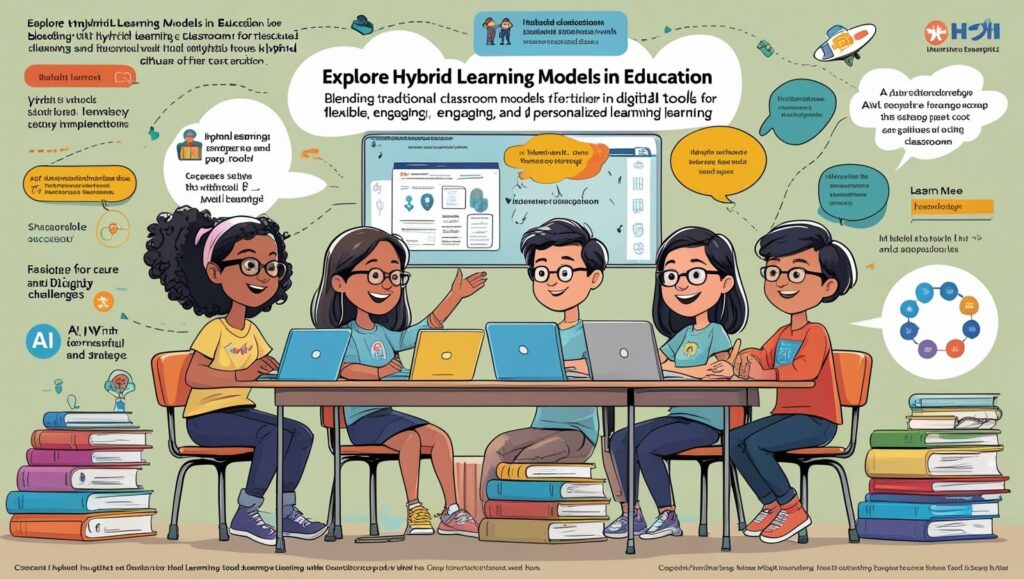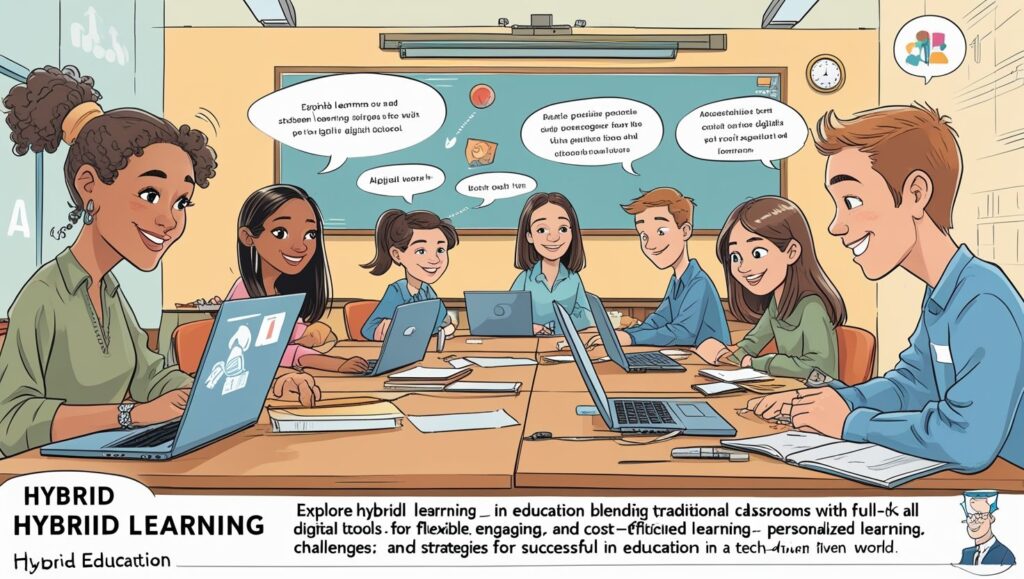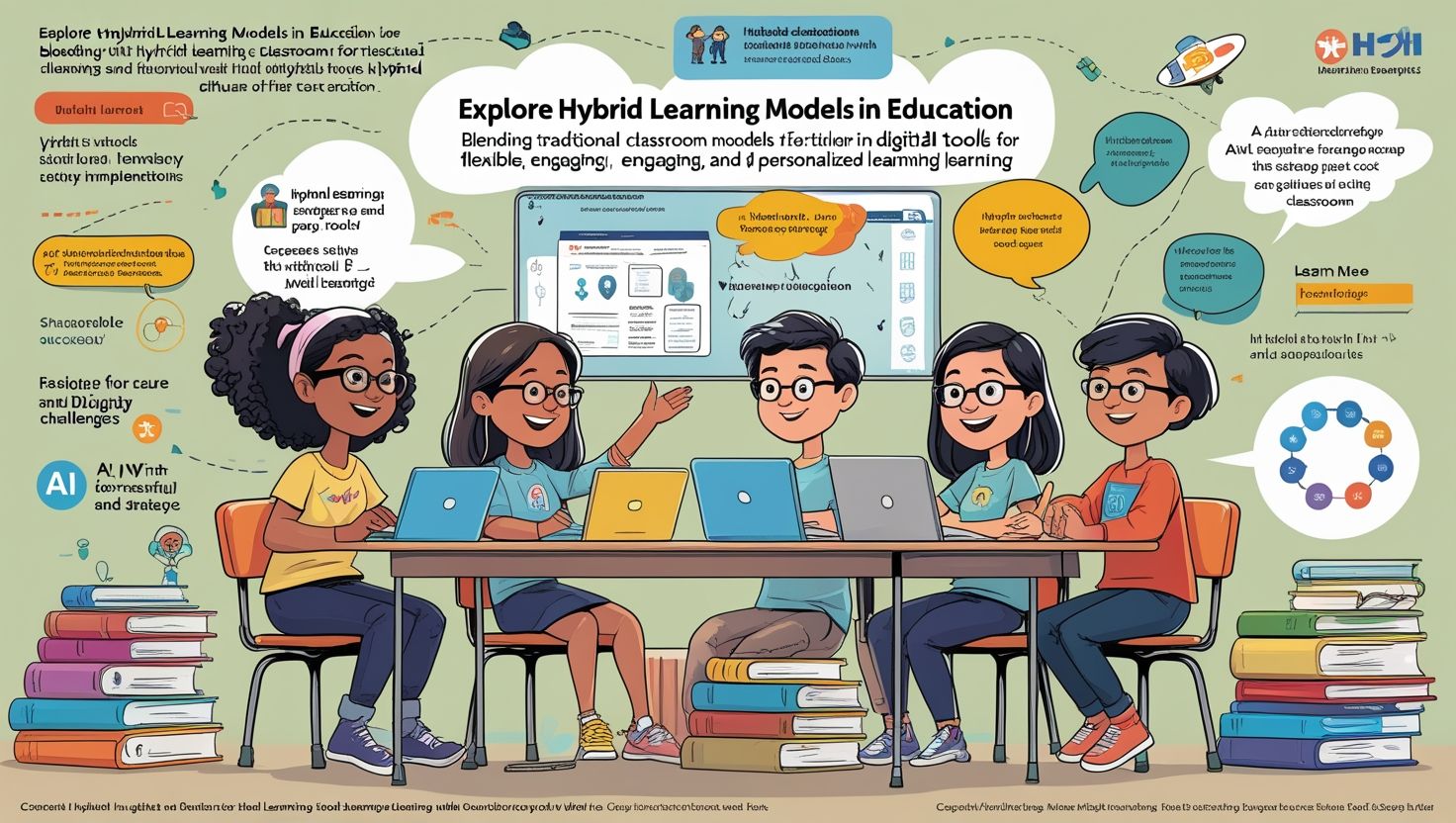Introduction
Hybrid Learning Models in Education and Digital Classrooms, The education sector has undergone significant transformations over the years, with technology playing a pivotal role in reshaping teaching and learning methodologies. One of the most impactful developments in recent years is the emergence of hybrid learning models, which combine traditional face-to-face instruction with online learning components. This approach provides flexibility, accessibility, and personalized learning experiences, making education more inclusive and adaptable to diverse student needs.
As schools and universities continue to embrace digital advancements, hybrid learning has become a cornerstone of modern education. This article explores the concept of hybrid learning, its benefits, challenges, implementation strategies, and future trends.
What is Hybrid Learning?
Hybrid learning, also known as blended learning, is an educational model that integrates in-person classroom instruction with online learning activities. Unlike fully online courses, hybrid learning maintains a physical classroom component while leveraging digital tools to enhance learning.
Key Characteristics of Hybrid Learning:
- Combination of Online and In-Person Learning – Students attend some classes physically while completing other coursework online.
- Flexible Scheduling – Learners can access materials and assignments at their own pace.
- Technology Integration – Uses Learning Management Systems (LMS), video conferencing, and interactive digital resources.
- Personalized Learning Paths – Adapts to individual student needs through data-driven insights.
Benefits of Hybrid Learning Models
1. Enhanced Flexibility and Accessibility
Hybrid learning allows students to balance education with work, family responsibilities, or other commitments. Those in remote areas or with mobility challenges benefit from online access to course materials.
2. Improved Student Engagement
Interactive digital tools such as gamification, discussion forums, and multimedia content make learning more engaging. Students can revisit recorded lectures and participate in collaborative online activities.
3. Personalized Learning Experiences
AI-driven analytics and adaptive learning platforms help educators tailor instruction based on individual student performance. This ensures that learners progress at their own pace.
4. Cost-Effectiveness for Institutions
Reduced reliance on physical infrastructure lowers operational costs. Schools can optimize resources by offering some courses online while maintaining essential in-person labs or workshops.
5. Better Preparation for the Digital Workforce
Hybrid learning equips students with digital literacy and remote collaboration skills, which are increasingly valuable in today’s job market.

Challenges of Hybrid Learning
Despite its advantages, hybrid learning presents several challenges that institutions must address:
1. Digital Divide and Accessibility Issues
Not all students have reliable internet access or devices, creating disparities in learning opportunities.
2. Student Motivation and Self-Discipline
Online components require strong time-management skills, which some learners may lack without structured classroom environments.
3. Teacher Training and Adaptation
Educators need professional development to effectively use digital tools and design engaging hybrid courses.
4. Assessment and Academic Integrity
Ensuring fair and cheat-proof online assessments remains a concern for institutions.
5. Maintaining Social Interaction
Reduced face-to-face interaction can impact student collaboration and emotional well-being.

Implementing Hybrid Learning Successfully
To maximize the benefits of hybrid learning, institutions should adopt strategic approaches:
1. Invest in Robust Technology Infrastructure
- Reliable Learning Management Systems (LMS) like Moodle, Canvas, or Blackboard.
- High-quality video conferencing tools (Zoom, Microsoft Teams).
- Interactive platforms (Kahoot!, Nearpod) for student engagement.
2. Provide Professional Development for Educators
- Training on digital pedagogy and hybrid course design.
- Workshops on using AI and analytics for personalized learning.
3. Ensure Equitable Access for All Students
- Offer loaner devices or subsidized internet plans.
- Provide offline learning materials for students with connectivity issues.
4. Design Engaging and Interactive Content
- Use multimedia (videos, podcasts, infographics) to enhance lessons.
- Incorporate discussion forums and group projects to foster collaboration.
5. Implement Effective Assessment Strategies
- Use proctored online exams or project-based evaluations.
- Leverage AI-driven plagiarism checkers to maintain academic integrity.
Future Trends in Hybrid Learning
As technology evolves, hybrid learning models will continue to advance. Key future trends include:
1. Artificial Intelligence (AI) and Adaptive Learning
AI-powered platforms will provide real-time feedback and customize learning paths based on student performance.
2. Virtual and Augmented Reality (VR/AR) Integration
Immersive technologies will enable virtual labs, simulations, and interactive 3D learning experiences.
3. Blockchain for Credentialing
Secure digital credentials and micro-certifications will streamline academic and professional recognition.
4. Increased Use of Learning Analytics
Data-driven insights will help educators identify at-risk students and optimize teaching strategies.
5. Expansion of Hybrid Learning in Corporate Training
Businesses will adopt hybrid models for employee upskilling and professional development.
Conclusion
Hybrid learning represents a transformative shift in education, offering a balanced approach that combines the best of traditional and digital learning. While challenges such as the digital divide and student engagement persist, strategic implementation can mitigate these issues.
As technology continues to evolve, hybrid learning will become even more sophisticated, providing personalized, accessible, and future-ready education. Institutions that embrace this model will be better positioned to meet the diverse needs of 21st-century learners and prepare them for an increasingly digital world.
By investing in infrastructure, teacher training, and equitable access, educators can ensure that hybrid learning delivers on its promise of high-quality, flexible, and inclusive education for all.

zk0y31